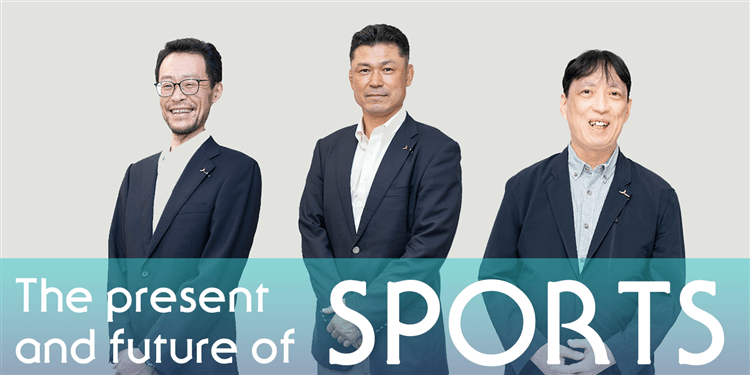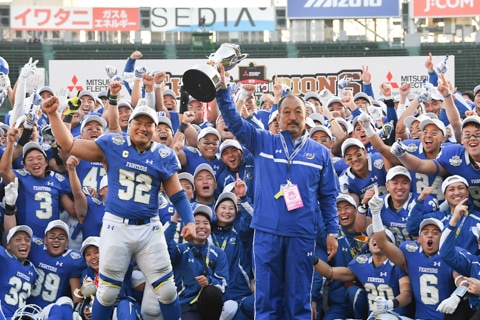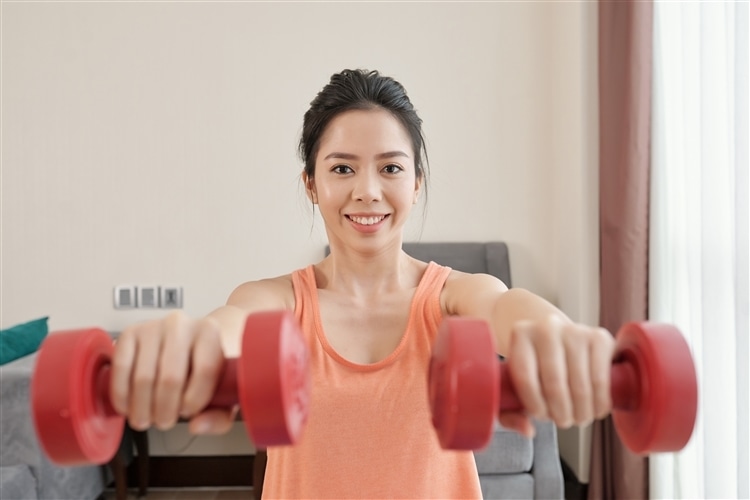- TOP
- Research
- Research Features List
- Roundtable
- Talk Deep: On The Present and Future of Sports


Participants (from left):
Akira Kurashima, Professor, School of Sociology (Sports sociology and body theory)
Hironobu Sato, Associate Professor, School of Human Welfare Studies (History of sports and martial arts studies)
Norihiko Saga, Professor, School of Engineering (Actuator engineering, robot engineering, human support engineering, and sports engineering)
The word "sport" can mean a variety of different things. For some, this concept does not only include participating in competitive sports, but also pursuing non-competitive activities as part of their daily lives, such as walking or going to the gym. Others get involved in sport by watching sports or by supporting a team.
In this edition of Talk Deep, the participants discussed sports from a multifaceted perspective, such as sports from a sociological viewpoint, how they are related to technology, and ways to be connected with them over the course of a lifetime.
Participating in sports means that you are being watched
Sato: At the School of Human Welfare Studies, I teach a course where students can acquire health and physical education teaching licenses. I teach judo as a practical training subject, and I teach Studies of Physical Arts and Adapted Sports (for those with disabilities) as lecture subjects. Our School also offers various sports courses which are available to students from other Schools. There are camp training and skiing/snowboarding training courses, among others, and I serve as director of the office which offers these courses.
Now, please introduce yourselves and your fields of research.
Saga: I was originally involved with the development of automobile devices at an electronics manufacturer. After that, I spent some time at Akita Prefectural University, when I turned to robotics research with a focus on control engineering, which I have been doing ever since. I specialize in mechatronic devices such as robots. At the moment, I am working in the field of biorobotics, with the aim of creating devices which that can be used effectively in real life by going into the brain and muscles of organisms and humans while using their functions, mechanisms, and thoughts as points of reference. I am involved with every aspect of development, which includes design, experimentation, and assessment. My research style is not to create from scratch, but to create by fusing various fields together.
Kurashima: In order to illustrate the nature of sport, I would like to start with an anecdote from my boyhood. I was a slow runner, and in school marathons, I was always one of the last to reach the finish line. This meant that I had to cross the line in front of a crowd of onlooking students who had long since finished and were chatting to pass the time, while I was panting my lungs out. In my young mind I thought, “What have I done to have this happen to me?” In ordinary school exams, students with the best grades sometimes have their names posted on the wall, but those with the worst grades do not, for good reason. Whereas in sports, public humiliation is part of the game. Being watched is a necessary condition to be judged the winner or loser, or to have a record set. Even the best athletes cannot decide on their own whether they have won or lost; they can never set their own record. Instead, they need to have somebody else, be it the judge or the spectators, to visually decide it for them. Thus, we can say that sport is an institution that establishes a visual hierarchy of bodies. This is the essence of sport as I understand it.
From an emphasis on guts and willpower to training founded on mechanics
Sato: Professor Saga, in your opinion, what is the value of sports?
Saga: I am involved with sports because they are an accumulation of dynamics. In judo, people often say that "small dominates large" and "softness dominates strength.” That is a logical, mechanically sensible way of thinking, and I feel that it has a depth that goes beyond merely moving the body. When I was in Akita, in preparation for the 2007 National Sports Festival, I worked as a scientific sports staff member to provide support for competitions that people are less familiar with, such as canoeing, fencing, and alpine skiing. When I looked at the top performers in a sport, I saw that they had a clear understanding of their sport’s mechanics, and they were always thinking about what the ideal form would look like and how they should train to achieve it. There are right-handed and left-handed people, and the advice to "train your right side more so that your left and right sides are even" is only applicable to athletes up to the junior high school level. Athletes who have competitions coming up on a daily basis, which are often critical ones that determine whether they may or may not advance to the National Sports Festival or participate in intercollegiate athletic meets, will not listen to such easygoing training proposals.
Sato: You have to achieve victory with your current physical characteristics, then.
Saga: In order to win the competition in front of you, you have to have a grasp of your current physical characteristics, then train and develop your form in a way that makes the most of them. For example, in canoeing competitions, even elite performers may have habits that make them unbalanced when their form is measured. However, they balance themselves well during actual competition, and have developed their own form for competition that allows them to gain maximum propulsion. Considering what it means that top athletes are those who excel at making the most of what they have, I understand that sports have changed in the last 20 years or so into something that cannot be won through guts or simple willpower alone.
Technological development in sport should go hand-in-hand with ethical considerations
Sato: The issue of prostheses is often brought up in the Olympics. Would it be possible to build prostheses that would improve an athlete’s record?
Saga: I think it would be possible. For example, international organizations in alpine skiing have established restrictions on shapes and materials for skis in order to limit acceleration. In competitive swimming, urethane swimsuits became an issue because swimmers who wore them repeatedly broke their own records. Prosthetic legs built for competitions, at least the ones we have today, have high tensile strength to produce explosive force, but are uncomfortable to walk on. What I mean by that is, “Could you walk normally with them?” I don’t think it’s a good idea in the world of sports to transcend human capabilities for competition.
Sato: What do you think sports should be like in the future, from a technological standpoint?

unregulated use in sports may pose ethical problems
Saga: That’s a difficult question. While technological development in sports would improve safety conditions for competitors, it would also allow them to demonstrate greater ability than they naturally have. Unless we set limits somewhere, then sports will cease to be sports. On the other hand, in an aging society with a declining birthrate, we have an increasing need for robots that exceed human capabilities to serve as substitutes for human labor. That’s where the dilemma lies.
By the time the world of sports realizes this problem, technology will already be a generation or two ahead. In this sense, although it will be difficult, we will need to develop technology with ethical issues always in mind.
An all-out competition under rules or a creative and social interaction of bodiesSato: Technological advancements are revolutionizing sports at tremendous speed. AI is being used to referee sport competitions and to study professional go players, and I feel that 3D printing will be used more and more. Perhaps we will see 3D-printed figures that look exactly like real people, which can be controlled from a distance and made to battle against each other. What do you think about the future of sports, Prof. Kurashima?
Kurashima: Rethinking sports is an attempt to overcome modernity itself, which has thrived on disproportionate emphasis on visual objectivity. As a means to counter this imbalance, I am studying the cross-school interaction of martial art practitioners.

to train for mutual improvement with minimal risk of injury
My point is that similar situations can be seen in the training of any martial art, including judo. For example, when your master is teaching you a new technique by applying it to you, you don't resist with full force. You sense with your body what the master wants to do to you, and you try to receive and appreciate the technique. At the root of this kind of relationship is consideration and respect for your opponent, which is “Rei” (etiquette) in the original sense of the word. On the other hand, in a sport competition, you are required to fight without reserve. Given how sport reduces the richness of physical exchange to serious, rule-governed competition, we would greatly benefit from envisioning its alternative: an activity that enables the creative and social aspects of bodily interaction to flourish.
This is all the more important if we are to recover the original idea of Rei; it should be something more than a code of conduct before and after an all-out match.
Understanding how bodies work, so that student sports are fun and injury-freeSato: I feel that these days, there is a strong temptation for us to think that the only thing that matters is winning or losing. If the areas that Prof. Kurashima mentioned were brought into closer focus, then we would be able to enjoy sports in a wider variety of ways. As for me, I’m someone who was utterly devoted to judo in my student days, and I only realized the importance of studying after I graduated. Prof. Saga, what do you think about student sports?
Saga: The most important thing with student sports is to avoid injury and have fun. It isn’t good to do anything to excess. In order to avoid injury, I would like students to have knowledge about how the muscles and bones of the human body come together to create movement, and to consider the burden on their muscles and joints if more stress is placed on them than they are capable of bearing. Those athletes who aim to be among the best in the country will not be able to improve their records unless they learn more about this subject.

Kurashima: Since our university has a large number of students devoted to sports, I would like to raise awareness that sport is a privileged activity. Athletic grounds and swimming pools are artificial spaces built with enormous amounts of money. Teammates and opponents are readily available only because they are all students, enjoying the “moratorium” period financially supported by parents or scholarships. Sport is possible only when space and time are set apart in this way; it is a privileged activity that requires huge resources. This is why, once students graduate and enter the workforce, the majority are forced to quit playing. However, I would also like to point out that competing under a set of rules is not the only way to share the joy of physical activity with others. I wish to encourage students to think about alternative physical pursuits that they can enjoy even after they lose their privileges.
Sato: There are many clubs at Kwansei Gakuin University with long and storied traditions, some of which have won national championships. Students who are into competitive sports would learn a great deal from studying our clubs' history. Also, if you delve into the history of the sport you are playing, as I did, you will definitely pick up things that will serve you well in the present. For students who are not involved in any kind of sport at the moment, I would like them to start moving. Enrolling in a sport science or health science course would be a good idea, since such courses offer opportunities to try all kinds of sports.
Living a rich and meaningful life through sports, for oneself and for the worldSaga: There are different sports which are close at hand for each person, depending on their age. For me, it was the tennis club at work and a small local ski resort. Enjoying easy sports with your friends when you are young will lead to a long-lasting familiarity with sports. Also, as you grow older, your health will depend more and more on your conscious effort to stay active—for example, through exercises that you can do on your own, such as walking or jumping rope. It would be nice if you could add some fun to your life, such as rewarding yourself with a beer every time you walk 10,000 steps.

it is now a widespread means of self-improvement
Kurashima: Not long ago, weight training was something athletes did to improve their performance. But these days, more and more people lift weights for reasons other than sports, such as improving posture, preventing premature aging, and relieving stress. They are doing it not to win over others, but as a means to face their own bodies. One of the signs of this change is the popularization of the term “inner muscle.” I think this is a positive trend.
Sato: I specialize in judo, so I’d like to wrap up our discussion with Jigoro Kano (the founder of judo). He said that the goal of judo was “perfecting oneself to benefit the world.” In order to make the world better, we need to refine our skills. This is really the school motto of Kwansei Gakuin: Mastery for Service. We have formulated the "Kwansei Grand Challenge 2039"—an ultra-long term development strategy based on our conception of the future—in anticipation of our 150th anniversary in 2039. The goal of the KGC is for all graduates to lead rich and meaningful lives in the times to come.
In order to achieve this goal, I believe that we need to think about what sports should ideally be, and that we play sports not only for ourselves, but also, ultimately, for the benefit of others around the world.
